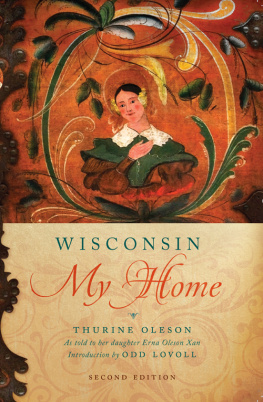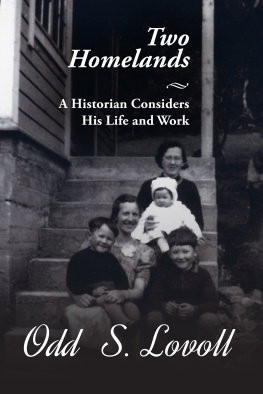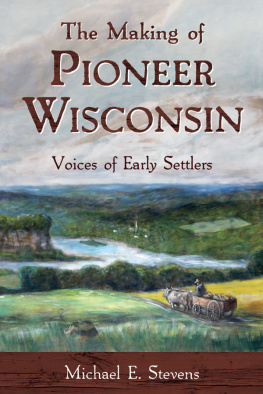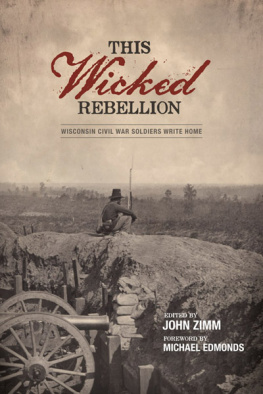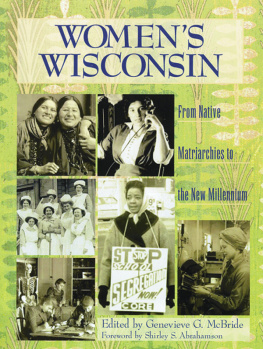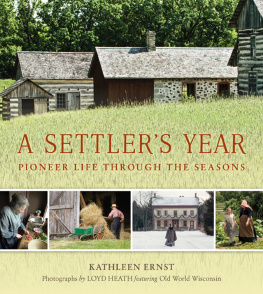WISCONSIN LAND AND LIFE
Arnold Alanen
Series Editor
WISCONSIN
MY HOME
THURINE OLESON
As told to her daughter
Erna Oleson Xan

THE UNIVERSITY OF WISCONSIN PRESS
The University of Wisconsin Press
1930 Monroe Street, 3rd Floor
Madison, Wisconsin 537112059
uwpress.wisc.edu
3 Henrietta Street
London WC2E 8LU, England
eurospanbookstore.com
Copyright 1950, 2012 by the Board of Regents of the University of Wisconsin System
All rights reserved. No part of this publication may be reproduced, stored in a retrieval system, or transmitted, in any format or by any means, digital, electronic, mechanical, photocopying, recording, or otherwise, or conveyed via the Internet or a website without written permission of the University of Wisconsin Press, except in the case of brief quotations embedded in critical articles and reviews.
Printed in the United States of America
LIBRARY OF CONGRESS CATALOGING-IN-PUBLICATION DATA
Oleson, Thurine, 1866
Wisconsin my home / Thurine Oleson as told to her daughter
Erna Oleson Xan. [2nd ed.]
p. cm. (Wisconsin land and life)
Introduction by Odd S. Lovoll.
ISBN 978-0-299-28874-7 (pbk. : alk. paper)
ISBN 978-0-299-28873-0 (e-book)
1. Oleson, Thurine, 1866 2. Frontier and pioneer life Wisconsin. 3. NorwegiansWisconsin. 4. WisconsinSocial life and customs. I. Xan, Erna Oleson, 1898 II. Lovoll, Odd Sverre. III. Title. IV. Series: Wisconsin land and life.
CT 275.045A3 2012
977.5'043092dc23
[B]
2012013285
Dedicated to
The Oleson Children
With all the love of our hearts
CONTENTS
ACKNOWLEDGMENTS
I N PREPARING this book, the authors are greatly indebted to various members of the family for their generous help with stories, pictures, and family lists. The genealogy was a winters work, and could not have been gathered together without the cheerful assistance of all the sisters and the cousins and the aunts.
The authors realize that there may be mistakes in the genealogy, although every name has been checked and double-checked by several people. In all cases we tried to contact the oldest members of the particular branch. Where families have moved to distant places and have not kept in touch with those back home, it was difficult to make the list complete. For this, we apologize. We hope the name-spellings are right. If there are mistakes, they were not intended.
We wish to thank in particular for their kind and painstaking assistance John M. and Isabel Olson and their daughter-in-law, Mabel; Sarah Uvaas and her daughters, Lillian and Myrtle; Clara Lindgren, Ole and Stella Thompson, Mable and Irene Johnson, and Ida Ziem; Henry and Lena Larsen, Julia Olson, Thone Olson and her daughter, Tillie Bockmann; Chris Thompson, Arthur and Hilda Larsen, Charlotte and Ellis Johnson, John Be of Buttes des Morts, Barney Barstow, Evelyn Baxandall, Herman Olson; and Cora and Harvey Peterson who went out in the dead of winter and read inscriptions on tombstones in Winneconne. We wish to thank especially Cousin Olav Be, Administrative Director of Norske Folk of Oslo, for the pictures of Gaarden Be and Sauland, and for the names of the descendants of Stor Ole Be. Without the help of these people and many others, we would have been greatly handicapped.
We also wish to thank Miss Mary Lou Warrick of Madison, Wisconsin, for the sketches used on the title and half-title pages.
And to John and Dixie Xan we express our deepest appreciation for their steadfast encouragement and support in all phases of the work.
T HE A UTHORS
INTRODUCTION
Odd S. Lovoll
W ISCONSIN , W ISCONSIN ! This is my home. This is how the books raconteur Thurine Oleson depicted how the young people in her family, in spite of hardships, viewed their circumstances and future prospects as landowners in the mid-nineteenth-century American Northwest. Thurine was born December 27, 1866, in Winchester in Winnebago County, Wisconsin, as the first of three children born in America to Mathis Olson Haevre and Thorild Andresdatter Be, who that year emigrated with their seven Norwegian-born children from Hjartdal in the north-central part of the mountainous Upper Telemarken district of Bratsberg amt, present-day Telemark fylke.
Thurines account of pioneer days in Wisconsin extends back to the early 1840s and the beginnings of Norwegian settlement in the state. Pioneering family members were among the earliest. All of our people came from Telemarken, Norway, she related, and Dozens and dozens of them had emigrated to the Town of Winchester in east central Wisconsin (1). The first of Thurines family to leave were her mothers older sister Anne Be and her husband, Torger Olsson Landsverk. They settled in the pioneer Muskego settlement on the shores of Lake Muskego in southern Wisconsin; they did their trading in Milwaukee, which at that time had only two stores. Milwaukee became from the 1840s a gateway for immigrants to Wisconsin and points farther west. Muskegos location partly explains its significance as a mother colony and a receiving station for Norwegian newcomers on their way west. The Muskego church, in use from the early fall of 1844, is considered by most people to be the first Norwegian Lutheran church in America. It was also in Muskego that the first Norwegian American newspaper, Nordlyset (Northern Lights), made its appearance in 1847.
Torger and Anne moved to the Town of Winchester, where other Norwegians had settled, in 1847. There they found rich, level land and prospered. Letters back home to Telemark, describing gently rolling fields of the blackest, richest soil, which One could get 160 acres of as a homestead for little or nothing (20), made the America fever take hold among their kin and convinced many of them to seek a better life across the Atlantic. Becoming tillers of the soil in America did indeed appeal to people confined to farming on the pocket-sized steep fields of home. Thurines parents decided to pack their goods and leave for America when they heard that the Civil War was over; so many immediate family members had gone to America, as Thurine relates, there were few left to grieve their departure for the New World.
Wisconsin became the main region of Norwegian settlement and Norwegian American activity until the Civil War. The Territory of Wisconsin was organized in 1836, and in 1848 it joined the Union as the thirtieth state. Ole Nattestad from Numedal, a valley east of Telemark, was the first Norwegian settler in Wisconsin. He and his brother Ansten Nattestad emigrated in 1837 and went first to the short-lived Beaver Creek settlement in Illinois. In the summer of 1838, while Ansten was back in Norway, Ole left Illinois and went to Wisconsin. He came to what would later become the Clinton Township in Rock County near Beloit, where he bought land and founded a settlement that became known as Jefferson Prairie. His later interview, published in A Chronicler of Immigrant Life: Svein Nilssons Articles in Billed-Magazin, 18681870, highlights the desolation and loneliness endured by pioneer settlers at that time. Except for eight Americans who had taken up land in the same township, as he recounted, for a whole year I did not see any countrymen of mine but lived secluded without friends, family or companions. The choice of land, however, was good. As Nattestad explained, the soil was very fertile, and the dreariness of the prairie was broken by scattered groves of trees. The settlement grew quickly when Ansten returned from Norway in the spring of 1839 with a large group of people, mainly from Numedal and Telemark.

